Managing a construction budget takes careful organization, accurate forecasting and constant oversight. A construction cost breakdown helps project teams understand exactly where their money is going and whether spending aligns with expectations. By mapping out all costs from labor to materials, managers can control overruns and improve profitability across every project phase.
This construction cost breakdown: how-to guide with example and template shows how clear cost segmentation leads to better financial control. It explains when to create a breakdown, who is responsible for preparing one and how using a construction cost breakdown template makes the process faster and more transparent. With the right approach, teams can turn complex project data into a powerful management tool.

Get your free
Construction Cost Breakdown Template
Use this free Construction Cost Breakdown Template to manage your projects better.
Get the Template
What Is a Construction Cost Breakdown?
A construction cost breakdown organizes every expense in a construction project into defined categories such as materials, labor, equipment and subcontractor fees. It provides a clear view of how each cost contributes to the total budget and helps prevent hidden or unexpected expenses. Project managers use it to track, control and forecast spending through every stage of the build.
Construction project management software improves this process by automating data entry, integrating budgets with schedules and allowing real-time cost tracking. Instead of juggling spreadsheets, teams can monitor performance, compare actual versus planned costs and generate accurate reports instantly.
ProjectManager enhances construction cost breakdown management through advanced features like interactive Gantt charts, multiple project views and AI-informed reports. The Gantt chart connects costs directly to tasks and timelines, making it easy to see financial impact as schedules evolve. Real-time dashboards and timesheets help identify cost variances early, while resource allocation tools ensure teams stay within budget. Get started with ProjectManager today for free.
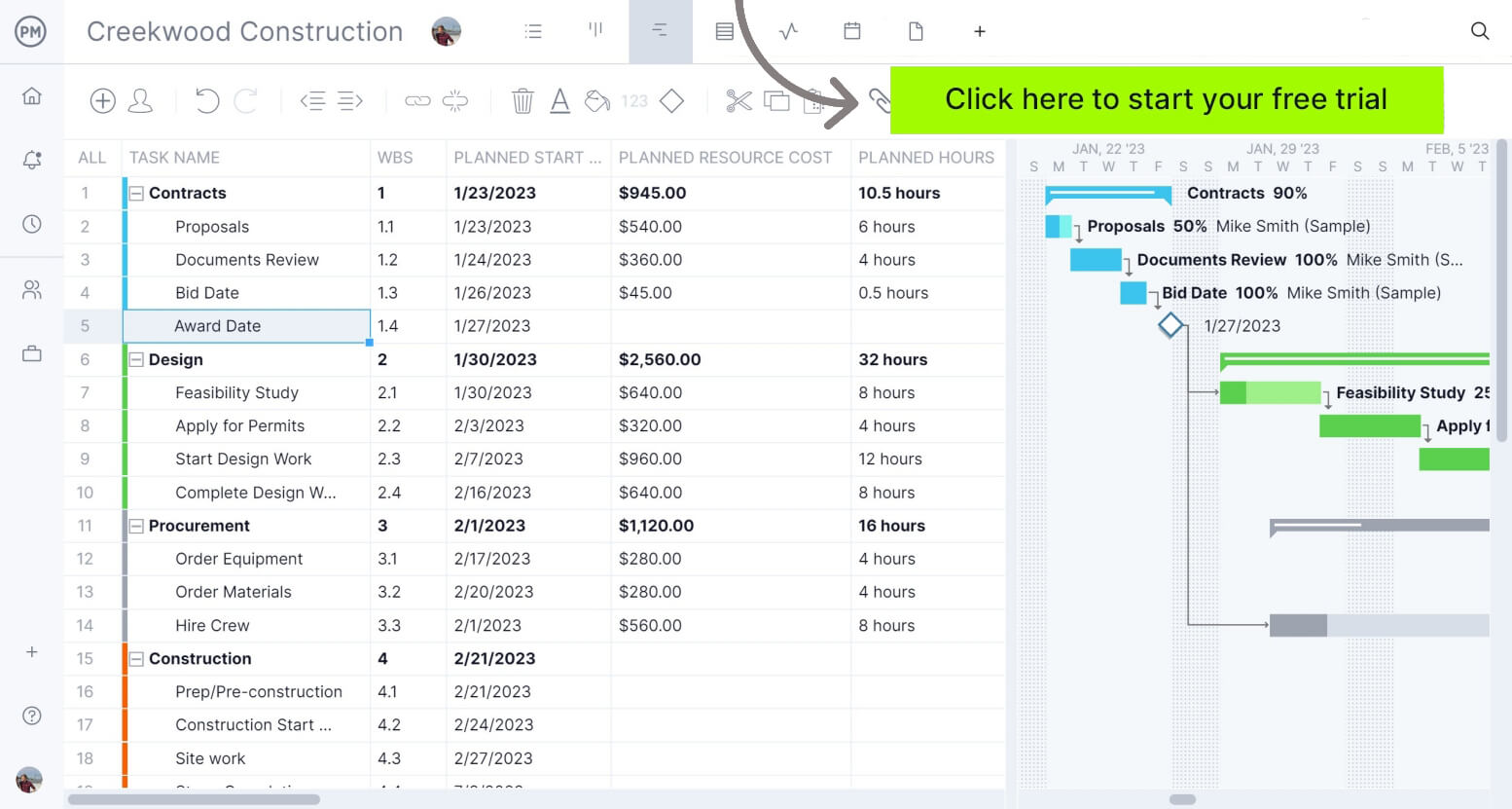
When to Create a Construction Cost Breakdown
A construction cost breakdown should be created during the early planning stages before project execution begins. Developing it at this stage ensures estimates are accurate, funding requirements are clear and stakeholders understand the financial scope. As the project progresses, the breakdown can be updated to reflect actual costs, allowing for better control and timely adjustments to keep budgets aligned with objectives.
Why It’s Important to Create a Construction Cost Breakdown
A construction cost breakdown is essential for maintaining financial control, improving decision-making and ensuring accountability. It allows managers to see where money is being spent and whether resources are being used efficiently. By dividing the project into cost components, it becomes easier to pinpoint overruns or inefficiencies before they escalate.
It also helps with forecasting, contract management and communication among stakeholders, making it a key part of financial transparency. Additionally, a construction cost breakdown template simplifies reporting for compliance, audits and performance reviews, creating a structured framework that supports long-term project success.
Related: 10 Free Construction Plan Templates for Excel & Word
Who Is Responsible for Preparing a Construction Cost Breakdown?
Typically, the project manager leads the creation of a construction cost breakdown, collaborating with estimators, accountants, engineers and procurement staff. Each department contributes data related to its area of responsibility, ensuring the final budget reflects all expected costs and contingencies. Clear ownership of cost elements helps maintain accuracy and accountability throughout the project.
Project Tasks
This section lists all major tasks associated with the project, breaking them into manageable components. Each task includes estimated labor, materials and equipment costs. Having this breakdown ensures teams understand the financial expectations tied to each activity, making it easier to monitor progress and cost performance as the work unfolds.

Project Deliverables
Deliverables define the tangible outcomes of each phase, such as completed structures or installed systems. Assigning specific costs to deliverables ensures accountability for scope and budget alignment. It also helps clients and stakeholders understand how resources are distributed across project milestones, which supports transparency in financial reporting.
Cost of Materials
This includes the cost of raw and finished materials used throughout the construction process, from concrete to electrical wiring. Accurate material tracking prevents shortages, delays and waste. Maintaining updated material costs within the construction cost breakdown allows for real-time adjustments if prices fluctuate during the project.
General Labor Cost
General labor costs account for wages, benefits and overtime for on-site personnel. Tracking labor costs ensures payroll stays aligned with project progress and prevents overspending. When paired with time-tracking tools, this part of the breakdown helps identify inefficiencies and supports better scheduling decisions.
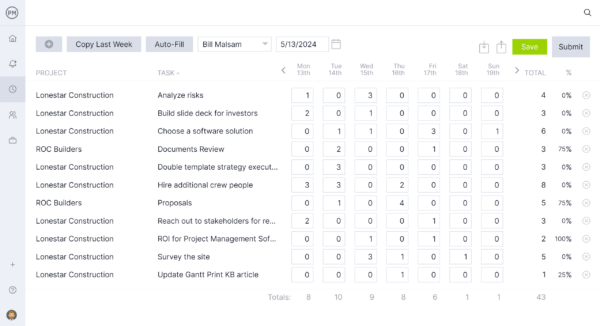
Subcontractor Costs
Subcontractor expenses include payments to specialized trades such as plumbing, electrical and HVAC services. Listing them in the construction project cost breakdown clarifies total outsourcing expenses. It also simplifies billing, contract management and performance tracking for external partners involved in the build.
Equipment Costs
Equipment costs capture expenses related to machinery purchase, rental and maintenance. This section helps determine whether owning or renting is more cost-effective for a given project. Keeping this data in a construction cost breakdown template ensures accurate forecasting and better long-term resource planning.
Logistics Costs
Logistics expenses cover transportation, delivery and storage of materials and equipment. Including logistics in the construction project cost breakdown example ensures that indirect costs are visible and accounted for. Proper tracking prevents schedule delays caused by supply chain bottlenecks or poor inventory management.
Cost of Permits and Fees
This category includes expenses for building permits, inspections, environmental assessments and other regulatory approvals. Including these in the cost breakdown ensures full compliance and helps prevent fines or delays. Accurate permit tracking also supports smooth communication with municipal authorities and inspectors.
Contingency Reserve and Management Reserve
These reserves cover unforeseen issues such as design errors, scope changes or weather delays. Including both contingency and management reserves in the breakdown ensures financial flexibility and risk preparedness. Monitoring these reserves helps project teams stay responsive when challenges arise.
Profit Margin
The profit margin represents the financial return expected after covering all project costs. Including this figure in the construction cost breakdown helps ensure profitability targets are maintained. Regularly reviewing the margin as part of ongoing cost tracking helps prevent erosion of profit due to scope changes or overruns.
Construction Cost Breakdown Template
Download this free construction cost breakdown template to help construction teams organize and manage their project expenses effectively. This Excel-based template allows users to categorize costs into labor, materials, equipment and subcontractor fees, providing a clear overview of where funds are allocated. It also includes sections for tracking quantities, unit costs and total amounts, facilitating accurate cost forecasting and budget management.
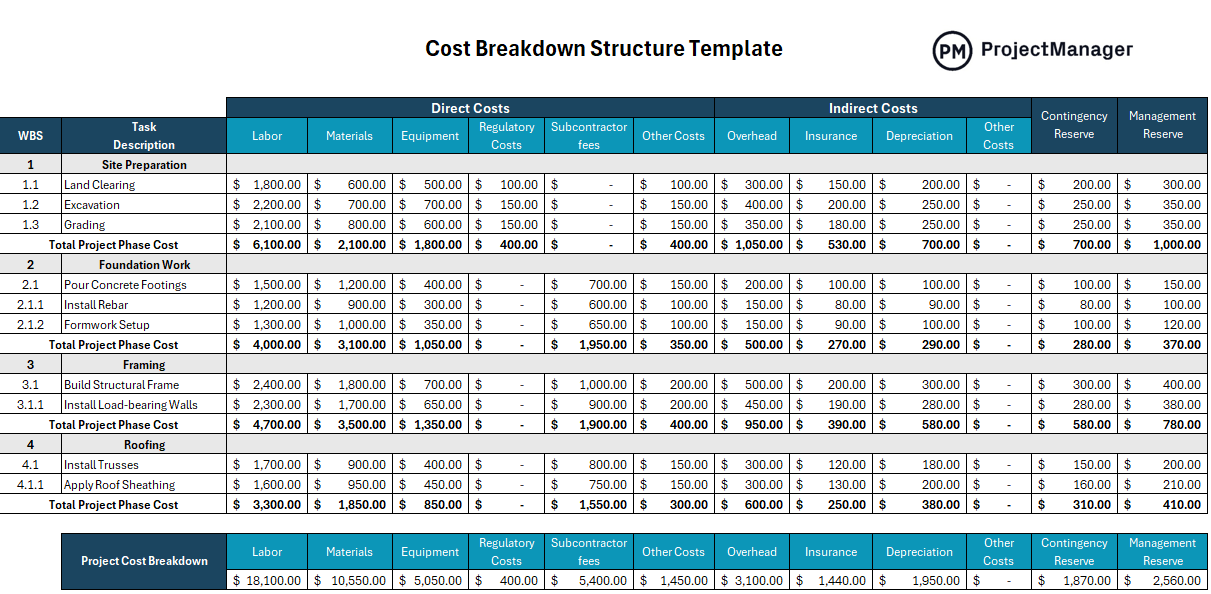
Ideal for contractors, project managers and estimators, this template streamlines the proposal process by offering a detailed, line-by-line breakdown of projected versus actual costs. Its structured format aids in securing faster approvals and ensures better alignment with stakeholders. By using this template, teams can maintain financial control throughout the project lifecycle, from initial estimates to final reporting.
Construction Cost Breakdown Example
Imagine a mid-sized construction firm, Horizon Builders Ltd., managing a 2,500-square-foot commercial office project in Austin, Texas. To understand and control costs effectively, the team followed a structured approach to break down the project scope, identify resource requirements and track costs.
Step 1: Break Down the Scope of Work
The first step is to list all major project tasks and their corresponding deliverables, priorities and responsible teams. This creates a clear roadmap of what needs to be done and who is accountable for each phase.

In this example, Horizon Builders started with site preparation, followed by foundation work, structural framing, MEP rough-ins, interior finishes and landscaping. Each task was assigned to specialized crews, from the excavation team to the landscaping crew, ensuring accountability and clear division of labor.
Step 2: Identify the Resource Requirements
Once the scope of work was defined, the next step was to identify the key cost categories associated with each task, including materials, equipment and labor.
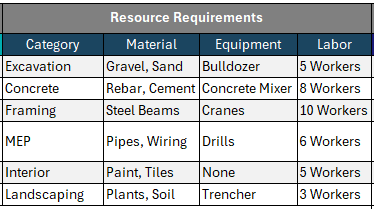
To keep it simple, the table below outlines a few representative categories for each phase. For example, the excavation required gravel, sand and a bulldozer with five workers, while the framing involved steel beams, cranes and a ten-person crew. These details help project managers plan procurement, allocate labor efficiently and estimate overall resource consumption.
Step 3: Compare Budgeted vs. Actual Costs
The final step is to track financial performance by comparing the budgeted costs with the actual expenses. This reveals where the project stayed on target and where deviations occurred.
In this case, the foundation work came in under budget by $2,000 thanks to efficient concrete use, while structural framing exceeded its estimate due to delayed steel deliveries and extra crane time. The MEP rough-ins saved $5,000 through coordinated installation, but landscaping overran costs after the client requested design upgrades.

Overall, Horizon Builders finished the project with an actual cost of $229,000, just $4,000 (1.8%) above the initial budget; a small variance that demonstrates how a detailed cost breakdown can help identify and control cost drivers across all project stages.
Free Related Construction Project Management Template
These free templates help construction teams plan, track and manage projects more efficiently. They provide a structured approach to budgeting, estimating and invoicing, making it easier to maintain financial control, communicate with stakeholders and ensure projects stay on schedule and within budget.
Construction Budget Template
Download this template to organize all project costs into clear categories such as labor, materials and equipment. By tracking planned versus actual expenses, teams can control overruns, forecast future spending and maintain profitability throughout the project lifecycle. It is ideal for creating a detailed financial roadmap for any construction project.
Construction Estimate Template
Use this free construction estimate template to create accurate cost projections for materials, labor and subcontractor work. It provides a line-by-line breakdown of quantities, unit costs and total expenses, simplifying the proposal process. Using this template ensures that estimates are transparent and aligned with client expectations, which helps secure faster approvals and reduces budget surprises.
Construction Invoice Template
This free template simplifies billing by generating professional invoices for completed work. It tracks payment schedules, amounts due and payment history, improving cash flow and record keeping. By standardizing the invoicing process, teams can focus on project execution while ensuring clients are billed accurately and on time.
ProjectManager Is Ideal to Make a Construction Cost Breakdown
ProjectManager is ideal for construction teams who need a centralized platform to plan, track and manage multiple projects at once. Its multiple project views allow managers to switch between Gantt charts, kanban boards and task lists, providing a clear picture of each project’s timeline and dependencies. The interactive Gantt chart links tasks directly to deadlines and budgets, while real-time dashboards display project health, progress and cost performance in a single view, helping teams make informed decisions quickly.
Learn more about our time tracking tools in this short video below.
Optimize Resource Management
ProjectManager helps construction teams allocate resources efficiently by tracking labor, equipment and materials across all projects. Resource workload charts show which team members are overallocated or underutilized, while timesheets allow field teams to log hours on site using the mobile app. Managers can forecast staffing needs, schedule subcontractors and track material usage in real time, viewing team members’ tasks, progress and priority on the team page, ensuring projects stay on budget and resources are never wasted.
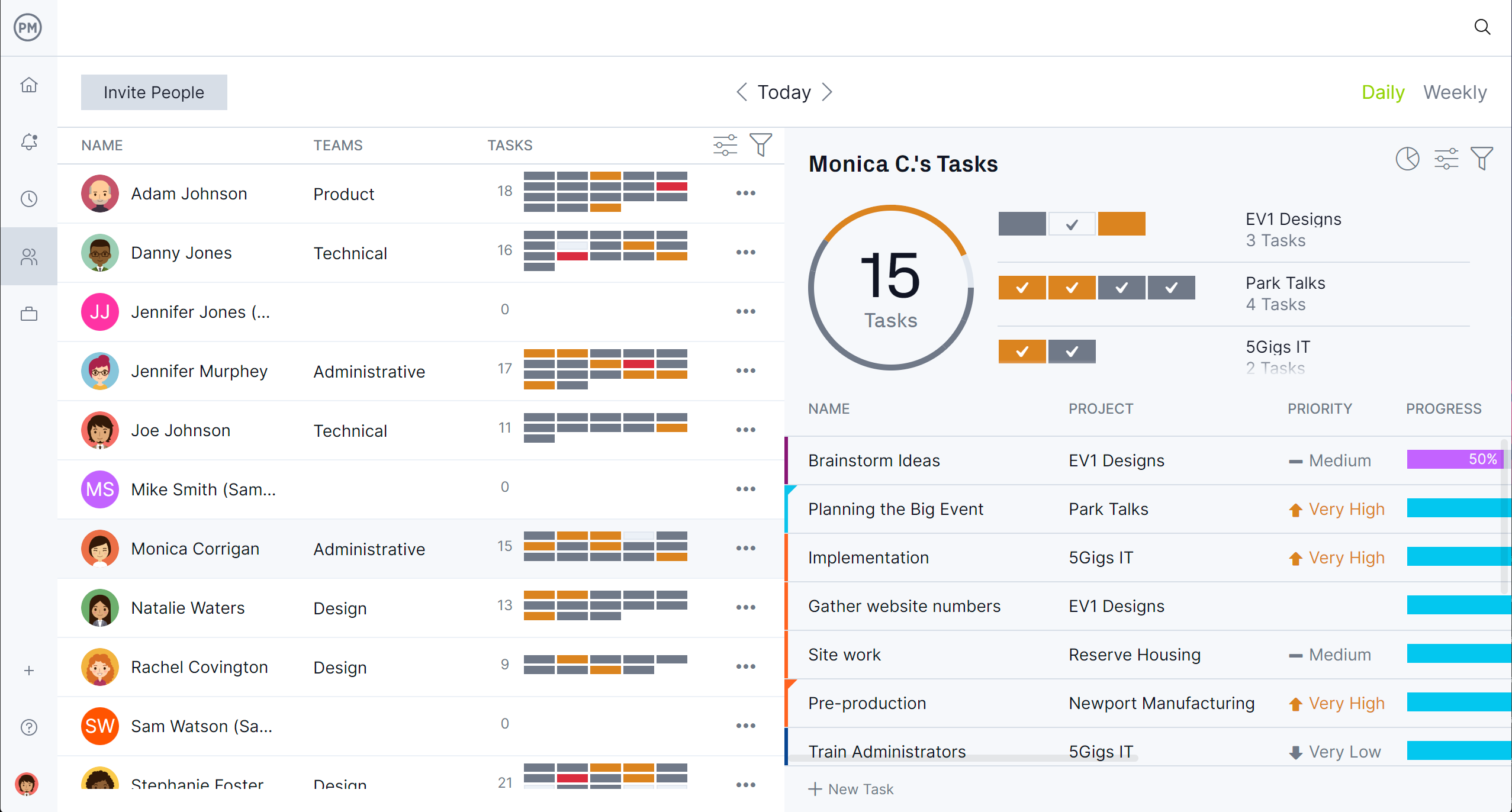
Enhance Tracking and Reporting
Tracking progress and performance is easy with ProjectManager’s built-in tools. Users can monitor task completion, compare actual costs versus planned budgets and generate AI-informed reports for stakeholders. Alerts notify teams of potential delays or budget overruns, while customizable dashboards give project managers instant insight into project metrics. By using these features, teams maintain accountability, ensure transparency and can respond quickly to changes in schedule or scope.
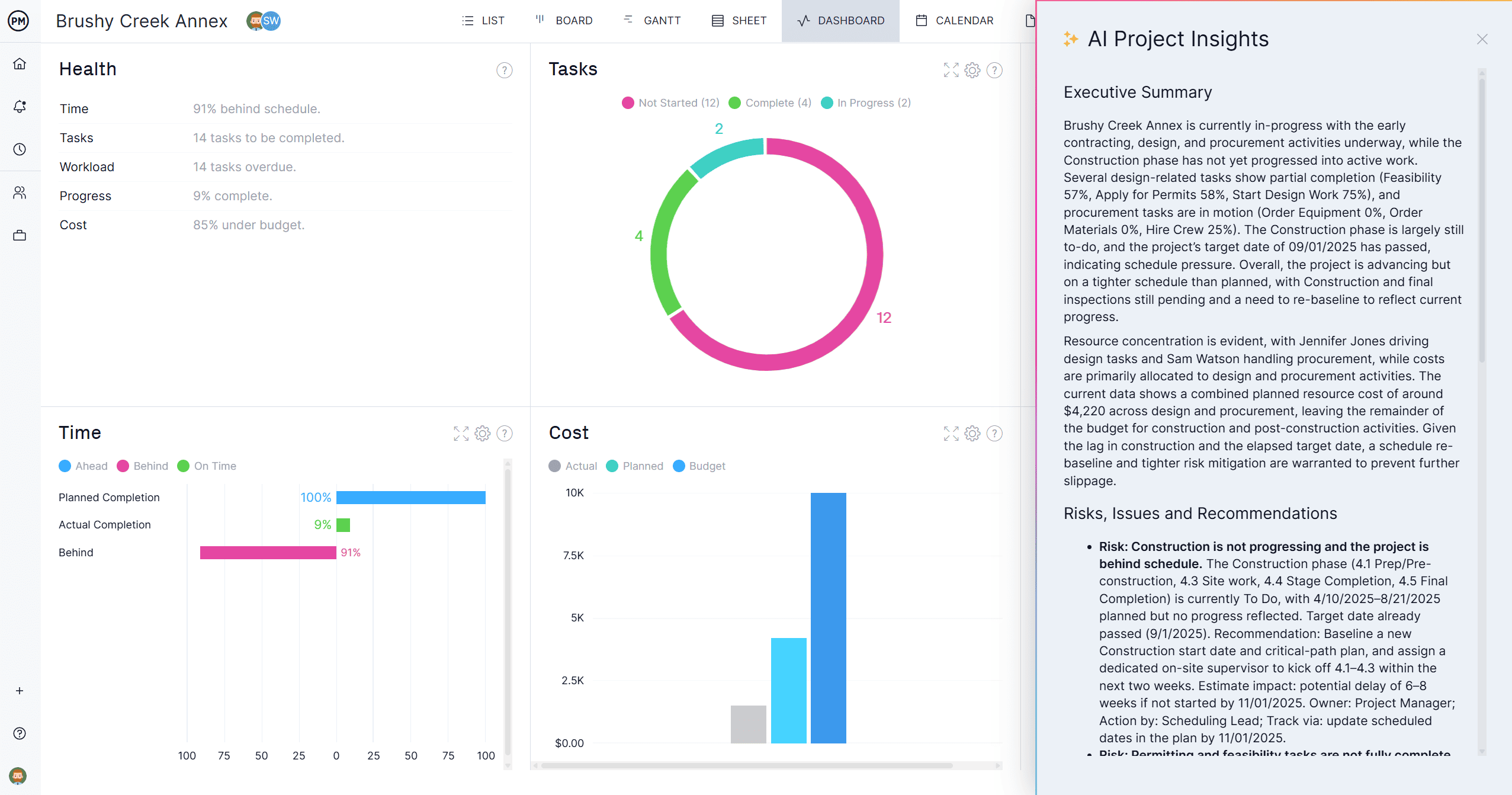
Related Construction Project Management Content
Construction cost breakdown is part of the larger construction project management process. For those who want to expand their knowledge and see costs in the context of the larger picture, check out the links below. There are articles on methods, techniques and more construction information.
- 32 Construction Documents (Templates Included)
- 10 Types of Construction Projects with Examples
- 18 Construction Methods and Techniques
- How to Make a Construction Plan
- Construction Phases: Documentation, Templates & Steps
ProjectManager is online project and portfolio management software that connects teams, whether they’re in the office or at the job site. They can share files, comment at the task level and stay up to date with email and in-app notifications. Get started with ProjectManager today for free.

